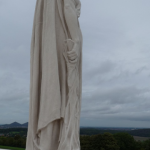MURRAY MACKAY WINCHESTER
 Murray Mackay Winchester was the uncle that Southampton’s Jane Kramer never got to meet.
Murray Mackay Winchester was the uncle that Southampton’s Jane Kramer never got to meet.
He was born in Victoria British Columbia on February 3, 1896, and was a younger brother to Jane’s dad, Paul. Their parents were Euphemia and Alex, who was a Presbyterian Minister. In 1901, the family moved to Toronto where Alex became the Senior Minister at Knox Presbyterian Church on Spadina Avenue. He served there until 1919 and the family lived in the church home at 30 Spadina Avenue.
As a young man, Murray left school and worked at the local Bank of Montreal. With the war raging in Europe, he enlisted in the Canadian Expeditionary Force on April 3, 1916. He signed up to the “220th (York Rangers) which was a Reinforcing Battalion. He applied for and was granted an officer’s commission.
Training began in Toronto, and it was six months later on September26, 1916 that he left for England from Halifax, arriving in Liverpool on October 10th. He immediately went to Shorncliffe in Kent which was a staging centre and training depot for Canadian Forces destined for Europe and France. He finished his training session on December 29, 1916 and was assigned to the 12th Reserve Battalion at East Sandling, the final training camp to prepare soldiers for trench fighting and also to await assignment to go to the war front.
While training at East Sandling, close to the English Channel, Murray came down with tonsillitis on February 9, !917 and was hospitalized for 4 days. Then, on March 20th, he got his call to the front and was assigned to the 75th Battalion. The 75th was battle hardened.
The Battalion had been formed in Toronto in early 1915 by Lieutenant Colonel Samuel G. Beckett who had been trained as a cavalry officer with the 9th Mississauga Horse. The 75th had been in Europe since arriving in England in April 1916. They had seen their first trench action in Belgium, that August, and then in France at the Somme and they had fought with distinction at the Regina and Desire Trenches later that year.
On the night of February 28 – March 1, 1917, the 75th was part of a multi-battalion sized raid on German positions at Hill 145 at Vimy Ridge. This was in preparation for the larger assault planned for five weeks later. A total of 1,700 from all ranks participated with 491 from the 75th. The battle involved the use of phosgene gas by the Canadians. This warned the Germans that an attack was coming, and they were fully prepared. The 75th lost nine officers and 112 other ranks from their total of 491 that had participated. Included among the dead was commanding officer, Lieutenant Colonel Samuel Beckett.
These losses so depleted the 75th Battalion that its participation in the planned main battle at Vimy Ridge was greatly weakened. It was this event that also meant that Murray MacKay Winchester got the call to join the 75th Battalion in France and ge arrived in France on March 24th and joined his group on the 26th. It was only a mere 14 days later, on April 9th, 1917, at 05:30 that the greatest battle ever fought by a Canadian Army began.
The 75th Battalion was in the middle trenches right in front of the dug-in German trenches. It was the Junior Officers that led the challenge out into No Man’s Land. The 75th was one of the first to lead the attack. At 15:00 hours the area assigned to the 75th was reported cleared and 40 German soldiers were brought in as prisoners. The next morning Lieutenant Murray Mackay Winchester did not answer roll call and was reported “Missing in Action”. The battle on Vimy Ridge continued until April 12 when the Canadians very proudly declared victory.
The final entries in the military record for Lieutenant Winchester read:
– Reported Missing between April 9th & 12th, 1917.
– All available evidence has been collected regarding the above-named missing soldier. Neither this office, the unit, the Base, nor the Canadian Red Cross Society, has any information suggesting that he may still be alive.
– Previous reports of missing, now for official purposes, are that he is presumed to have died on or since April 9th, 1917.
No Man’s Land today
Murray Winchester’s name is on the Vimy Memorial along with 11,824 other Canadian soldiers who died in France during that horrible war and whose final resting places are unknown.
For larger views, Click on Images
Every year, thousands of Canadians and others visit the Vimy Battlefield and the Memorial. This sacred land has, in fact, been deeded to Canada by France and the information centre is staffed by McGill University students.
On April 3rd, 2003 the Canadian Government passed Bill C-227 declaring that April 9th would forever more be known as “Vimy Ridge Day”.
The preamble to the Bill reads:
WHEREAS, the Battle of Vimy Ridge on April 9, 1917 was the first time that Canadians from coast to coast fought together against a common enemy;
AND WHEREAS the battle of Vimy Ridge is considered by many to be a turning point for our country and the beginning of Canada’s march towards Nationhood;
NOW; THEREFORE Her Majesty, by and with the advice and consent of the Senate and House of Commons of Canada enacts as follows:
1. This act may be cited as the Vimy Ridge Day Act.
2. Throughout Canada, in each and every year, the 9th Day of April will be known as “VIMY RIDGE DAY”.
WE WILL REMEMBER THEM
Researched and written by:
G. William Streeter



















